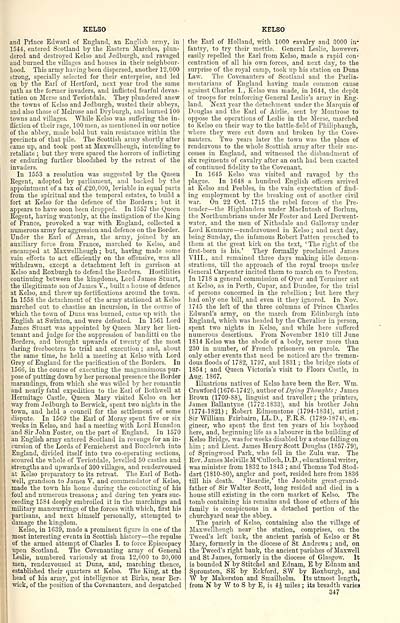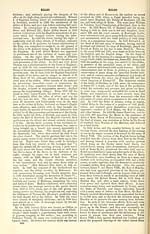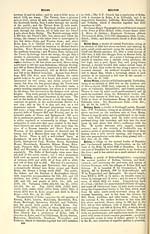Ordnance gazetteer of Scotland > Volume 4
(129) Page 347 - KEL
Download files
Complete book:
Individual page:
Thumbnail gallery: Grid view | List view

KELSO
KELSO
and Prince Edward of England, an English army, in
1544, entered Scotland by the Eastern Marches, plun-
dered and destroyed Kelso and Jedburgh, and ravaged
and burned the villages and houses in their neighbour-
hood. This army having been dispersed, another 12,000
strong, specially selected for their enterprise, and led
on by the Earl of Hertford, next year trod the same
path as the former invaders, and inflicted fearful devas-
tation on Merse and Teviotdale. They plundered anew
the towns of Kelso and Jedburgh, wasted their abbeys,
and also those of Melrose and Dryburgh, and burned 100
towns and villages. While Kelso was suffering the in-
fliction of their rage, 100 men, as mentioned in our notice
of the abbey, made bold but vain resistance within the
precincts of that pile. The Scottish army shortly after
came up, and took post at Maxwellheugh, intending to
retaliate ; but they were spared the horrors of inflicting
or enduring further bloodshed by the retreat of the
invaders.
In 1553 a resolution was suggested by the Queen
Regent, adopted by parliament, and backed by the
appointment of a tax of £20,000, leviable in equal parts
from the spiritual and the temporal estates, to build a
fort at Kelso for the defence of the Borders ; but it
appears to have soon been dropped. In 1557 the Queen
Kegent, having wantonly, at the instigation of the King
of France, provoked a war with England, collected a
numerous army for aggression and defence on the Border.
Under the Earl of Arran, the army, joined by an
auxiliary force from France, marched to Kelso, and
encamped at Maxwellheugh ; but, having made some
vain efforts to act efficiently on the offensive, was all
withdrawn, except a detachment left in garrison at
Kelso and Roxburgh to defend the Borders. Hostilities
continuing between the kingdoms, Lord James Stuart,
the illegitimate son of James V., built a house of defence
at Kelso, and threw up fortifications around the town.
In 155S the detachment of the army stationed at Kelso
marched out to chastise an incursion, in the course of
which the town of Duns was burned, came up with the
English at Swinton, and were defeated. In 1561 Lord
James Stuart was appointed by Queen Mary her lieu-
tenant and judge for the suppression of banditti on the
Borders, and brought upwards of twenty of the most
daring freebooters to trial and execution ; and, about
the same time, lie held a meeting at Kelso with Lord
Grey of England for the pacification of the Borders. In
1566, in the course of executing the magnanimous pur-
pose of putting down by her personal presence the Border
maraudings, from which she was wiled by her romantic
and nearly fatal expedition to the Earl of Bothwell at
Hermitage Castle, Queen Mary visited Kelso on her
way from Jedburgh to Berwick, spent two nights in the
town, and held a council for the settlement of some
dispute. In 1569 the Earl of Moray spent five or sLx
weeks in Kelso, and had a meeting with Lord Hunsdon
and Sir John Foster, on the part of England. In 1570
an English army entered Scotland in revenge for an in-
cursion of the Lords of Fernieherst and Buccleuch into
England, divided itself into two co-operating sections,
scoured the whole of Teviotdale, levelled 50 castles and
strengths and upwards of 300 villages, and rendezvoused
at Kelso preparatory to its retreat. The Earl of Both-
well, grandson to James V. and commendator of Kelso,
made the town his home during the concocting of his
foul and numerous treasons ; and during ten years suc-
ceeding 1584 deeply embroiled it in the marchings and
military manceuvrings of the forces with which, first his
partisans, and next himself personally, attempted to
damage the kingdom.
Kelso, in 1639, made a prominent figure in one of the
most interesting events in Scottish history — the repulse
of the armed attempt of Charles I. to force Episcopacy
upon Scotland. The Covenanting army of General
Leslie, numbered variously at from 12,000 to 30,000
men, rendezvoused at Duns, and, marching thence,
established their quarters at Kelso. The King, at the
head of his army, got intelligence at Birks, near Ber-
wick, of the position of the Covenanters, and despatched
the Earl of Holland, with 1000 eavalry and 3000 in-
fantry, to try their mettle. General Leslie, however,
easily repelled the Earl from Kelso, made a rapid con-
centration of all his own forces, and next day, to the
surprise of the royal camp, took up his station on Duns
Law. The Covenanters of Scotland and the Parlia-
mentarians of England having made common cause
against Charles I., Kelso was made, in 1644, the depot
of troops for reinforcing General Leslie's army in Eng-
land. Next year the detachment under the Marquis of
Douglas and the Earl of Airlie, sent by Montrose to
oppose the operations of Leslie in the Merse, marched
to Kelso on their way to the battle-field of Philiphaugh,
where they were cut down and broken by the Cove-
nanters. Two years later the town was the place of
rendezvous to the whole Scottish army after their suc-
cesses in England, and witnessed the disbandment of
six regiments of cavalry after an oath had been exacted
of continued fidelity to the Covenant.
In 1645 Kelso was visited and ravaged by the
plague. In 1648 a hundred English officers arrived
at Kelso and Peebles, in the vain expectation of find-
ing employment by the breaking out of another civil
■war. On 22 Oct. 1715 the rebel forces of the Pre-
tender — the Highlanders under Macintosh of Borlum,
the Northumbrians under Mr Foster and Lord Derwent-
water, and the men of Nithsdale and Galloway under
Lord Kenmure— rendezvoused in Kelso ; and next day,
being Sunday, the infamous Robert Patten preached to
them at the great kirk on the text, ' The right of the
first-born is his.' They formally proclaimed James
VIII., and remained three days making idle demon-
strations, till the approach of the royal troops under
General Carpenter incited them to march on to Preston.
In 171S a general commission of Oyer and Terminer sat
at Kelso, as in Perth, Cupar, and Dundee, for the trial
of persons concerned in the rebellion ; but here they
had only one bill, and even it they ignored. In Nov.
1745 the left of the three columns of Prince Charles
Edward's army, on the march from Edinburgh into
England, which was headed by the Chevalier in person,
spent two nights in Kelso, and while here suffered
numerous desertions. From November 1810 till June
1814 Kelso was the abode of a body, never more than
230 in number, of French prisoners on parole. The
only other events that need be noticed are the tremen-
dous floods of 1782, 1797, and 1831 ; the bridge riots of
1854 ; and Queen Victoria's visit to Floors Castle, in
Aug. 1867.
Illustrious natives of Kelso have been the Rev. Win.
Crawford (1676-1742), author of Dying Thoughts ; James
Brown (1709-88), linguist and traveller ; the printers,
James Ballantyne (1772-1833), and his brother John
(1774-1821); Robert Edmonstone (1794-1834), artist;
Sir William Fairbairn, LL.D., F.R.S. (1789-1874), en-
gineer, who spent the first ten years of his boyhood
here, and, beginning life as a labourer in the building of
Kelso Bridge, was for weeks disabled by a stone falling on
him ; and Lieut. James Henry Scott Douglas (1S57-79),
of Springwood Park, who fell in the Zulu war. The
Rev. James Melville M 'Culloch, D. D. , educational writer,
was minister from 1832 to 1843 ; and Thomas Tod Stod-
dart (1810-80), angler and poet, resided here from 1S36
till his death. 'Beardie,' the Jacobite great-grand-
father of Sir Walter Scott, long resided and died in a
house still existing in the corn market of Kelso. The
tomb containing his remains and those of others of his
family is conspicuous in a detached portion of the
churchyard near the abbey.
The parish of Kelso, containing also the village of
Maxwellheugh near the station, comprises, on the
Tweed's left bank, the ancient parish of Kelso or St
Mary, formerly in the diocese of St Andrews ; and, on
the Tweed's right bank, the ancient parishes of Maxwell
and St James, formerly in the diocese of Glasgow. It
is bounded N by Stitchel and Ednam, E by Ednam and
Sprouston, SE by Eckford, SW by Roxburgh, and
W by Makerston and Smailholm. Its utmost length,
from N by W to S by E, is 4 J miles ; its breadth varies
347
KELSO
and Prince Edward of England, an English army, in
1544, entered Scotland by the Eastern Marches, plun-
dered and destroyed Kelso and Jedburgh, and ravaged
and burned the villages and houses in their neighbour-
hood. This army having been dispersed, another 12,000
strong, specially selected for their enterprise, and led
on by the Earl of Hertford, next year trod the same
path as the former invaders, and inflicted fearful devas-
tation on Merse and Teviotdale. They plundered anew
the towns of Kelso and Jedburgh, wasted their abbeys,
and also those of Melrose and Dryburgh, and burned 100
towns and villages. While Kelso was suffering the in-
fliction of their rage, 100 men, as mentioned in our notice
of the abbey, made bold but vain resistance within the
precincts of that pile. The Scottish army shortly after
came up, and took post at Maxwellheugh, intending to
retaliate ; but they were spared the horrors of inflicting
or enduring further bloodshed by the retreat of the
invaders.
In 1553 a resolution was suggested by the Queen
Regent, adopted by parliament, and backed by the
appointment of a tax of £20,000, leviable in equal parts
from the spiritual and the temporal estates, to build a
fort at Kelso for the defence of the Borders ; but it
appears to have soon been dropped. In 1557 the Queen
Kegent, having wantonly, at the instigation of the King
of France, provoked a war with England, collected a
numerous army for aggression and defence on the Border.
Under the Earl of Arran, the army, joined by an
auxiliary force from France, marched to Kelso, and
encamped at Maxwellheugh ; but, having made some
vain efforts to act efficiently on the offensive, was all
withdrawn, except a detachment left in garrison at
Kelso and Roxburgh to defend the Borders. Hostilities
continuing between the kingdoms, Lord James Stuart,
the illegitimate son of James V., built a house of defence
at Kelso, and threw up fortifications around the town.
In 155S the detachment of the army stationed at Kelso
marched out to chastise an incursion, in the course of
which the town of Duns was burned, came up with the
English at Swinton, and were defeated. In 1561 Lord
James Stuart was appointed by Queen Mary her lieu-
tenant and judge for the suppression of banditti on the
Borders, and brought upwards of twenty of the most
daring freebooters to trial and execution ; and, about
the same time, lie held a meeting at Kelso with Lord
Grey of England for the pacification of the Borders. In
1566, in the course of executing the magnanimous pur-
pose of putting down by her personal presence the Border
maraudings, from which she was wiled by her romantic
and nearly fatal expedition to the Earl of Bothwell at
Hermitage Castle, Queen Mary visited Kelso on her
way from Jedburgh to Berwick, spent two nights in the
town, and held a council for the settlement of some
dispute. In 1569 the Earl of Moray spent five or sLx
weeks in Kelso, and had a meeting with Lord Hunsdon
and Sir John Foster, on the part of England. In 1570
an English army entered Scotland in revenge for an in-
cursion of the Lords of Fernieherst and Buccleuch into
England, divided itself into two co-operating sections,
scoured the whole of Teviotdale, levelled 50 castles and
strengths and upwards of 300 villages, and rendezvoused
at Kelso preparatory to its retreat. The Earl of Both-
well, grandson to James V. and commendator of Kelso,
made the town his home during the concocting of his
foul and numerous treasons ; and during ten years suc-
ceeding 1584 deeply embroiled it in the marchings and
military manceuvrings of the forces with which, first his
partisans, and next himself personally, attempted to
damage the kingdom.
Kelso, in 1639, made a prominent figure in one of the
most interesting events in Scottish history — the repulse
of the armed attempt of Charles I. to force Episcopacy
upon Scotland. The Covenanting army of General
Leslie, numbered variously at from 12,000 to 30,000
men, rendezvoused at Duns, and, marching thence,
established their quarters at Kelso. The King, at the
head of his army, got intelligence at Birks, near Ber-
wick, of the position of the Covenanters, and despatched
the Earl of Holland, with 1000 eavalry and 3000 in-
fantry, to try their mettle. General Leslie, however,
easily repelled the Earl from Kelso, made a rapid con-
centration of all his own forces, and next day, to the
surprise of the royal camp, took up his station on Duns
Law. The Covenanters of Scotland and the Parlia-
mentarians of England having made common cause
against Charles I., Kelso was made, in 1644, the depot
of troops for reinforcing General Leslie's army in Eng-
land. Next year the detachment under the Marquis of
Douglas and the Earl of Airlie, sent by Montrose to
oppose the operations of Leslie in the Merse, marched
to Kelso on their way to the battle-field of Philiphaugh,
where they were cut down and broken by the Cove-
nanters. Two years later the town was the place of
rendezvous to the whole Scottish army after their suc-
cesses in England, and witnessed the disbandment of
six regiments of cavalry after an oath had been exacted
of continued fidelity to the Covenant.
In 1645 Kelso was visited and ravaged by the
plague. In 1648 a hundred English officers arrived
at Kelso and Peebles, in the vain expectation of find-
ing employment by the breaking out of another civil
■war. On 22 Oct. 1715 the rebel forces of the Pre-
tender — the Highlanders under Macintosh of Borlum,
the Northumbrians under Mr Foster and Lord Derwent-
water, and the men of Nithsdale and Galloway under
Lord Kenmure— rendezvoused in Kelso ; and next day,
being Sunday, the infamous Robert Patten preached to
them at the great kirk on the text, ' The right of the
first-born is his.' They formally proclaimed James
VIII., and remained three days making idle demon-
strations, till the approach of the royal troops under
General Carpenter incited them to march on to Preston.
In 171S a general commission of Oyer and Terminer sat
at Kelso, as in Perth, Cupar, and Dundee, for the trial
of persons concerned in the rebellion ; but here they
had only one bill, and even it they ignored. In Nov.
1745 the left of the three columns of Prince Charles
Edward's army, on the march from Edinburgh into
England, which was headed by the Chevalier in person,
spent two nights in Kelso, and while here suffered
numerous desertions. From November 1810 till June
1814 Kelso was the abode of a body, never more than
230 in number, of French prisoners on parole. The
only other events that need be noticed are the tremen-
dous floods of 1782, 1797, and 1831 ; the bridge riots of
1854 ; and Queen Victoria's visit to Floors Castle, in
Aug. 1867.
Illustrious natives of Kelso have been the Rev. Win.
Crawford (1676-1742), author of Dying Thoughts ; James
Brown (1709-88), linguist and traveller ; the printers,
James Ballantyne (1772-1833), and his brother John
(1774-1821); Robert Edmonstone (1794-1834), artist;
Sir William Fairbairn, LL.D., F.R.S. (1789-1874), en-
gineer, who spent the first ten years of his boyhood
here, and, beginning life as a labourer in the building of
Kelso Bridge, was for weeks disabled by a stone falling on
him ; and Lieut. James Henry Scott Douglas (1S57-79),
of Springwood Park, who fell in the Zulu war. The
Rev. James Melville M 'Culloch, D. D. , educational writer,
was minister from 1832 to 1843 ; and Thomas Tod Stod-
dart (1810-80), angler and poet, resided here from 1S36
till his death. 'Beardie,' the Jacobite great-grand-
father of Sir Walter Scott, long resided and died in a
house still existing in the corn market of Kelso. The
tomb containing his remains and those of others of his
family is conspicuous in a detached portion of the
churchyard near the abbey.
The parish of Kelso, containing also the village of
Maxwellheugh near the station, comprises, on the
Tweed's left bank, the ancient parish of Kelso or St
Mary, formerly in the diocese of St Andrews ; and, on
the Tweed's right bank, the ancient parishes of Maxwell
and St James, formerly in the diocese of Glasgow. It
is bounded N by Stitchel and Ednam, E by Ednam and
Sprouston, SE by Eckford, SW by Roxburgh, and
W by Makerston and Smailholm. Its utmost length,
from N by W to S by E, is 4 J miles ; its breadth varies
347
Set display mode to: Large image | Transcription
Images and transcriptions on this page, including medium image downloads, may be used under the Creative Commons Attribution 4.0 International Licence unless otherwise stated. ![]()
| Gazetteers of Scotland, 1803-1901 > Ordnance gazetteer of Scotland > Volume 4 > (129) Page 347 - KEL |
|---|
| Permanent URL | https://digital.nls.uk/97381894 |
|---|
| Attribution and copyright: |
|
|---|---|

